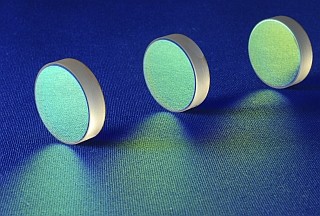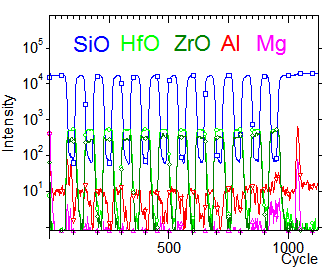Analysis of Multilayers (Layer Systems)
From Optics to Semiconductors
Metallic multilayer systems are used in many different ways on many substrates. They are an integral part of many optical components (e.g. lenses, dielectric or dichroic mirrors, interference filters ...). Multilayer systems are also used as heat protection layers on glass, to improve electrical contacts on metals, as complex layer systems in semiconductors and to enhance the look of plastics. In some cases, functionalized surfaces play a role. The use of surface analysis techniques can be very useful both in the development of new multilayer coating systems and in quality assurance.
A variety of analytical techniques are available in our laboratory and, depending on the analytical question or the respective defect, we have the experience to select the best technique or combination of techniques to answer the specific question of interest. Both ToF-SIMS and XPS can be used to characterize multilayer systems. A ToF-SIMS depth profile analysis enables the layer structure and layer composition to be characterized very precisely. Traces of impurities in the layer system or at interfaces can also be detected and identified with high sensitivity. Layer sequences and layer thicknesses can be analyzed. XPS is particularly useful when the chemical bonding of the elements in the layers or the precise quantification in the individual layers of the multilayer layer system is of interest. Other techniques, such as electron microscopy (REM-EDX), are also available.
The following example from our laboratory shows a case in the field of damage analysis and quality assurance. The strengths of the ToF-SIMS depth profile analysis on optical glasses become clear here.

Failure of laser mirrors
Trace impurities with major effects
After a short period of operation, the quality of a dielectric laser mirror was below the manufacturer's specification. Analysis by White Light Interferometry (WLI) provide not clues to the cause of the failure. Contamination of the glass substrate or contamination of the metal oxide layers was therefore suspected as a source of the failure. Therefore, ToF-SIMS depth profiling was used to identify the presence of contaminants such as polishes, organic contaminants, surfactants, etc. within the multilayer coating structure. Due to the sensitive, parallel detection of all elements, the ToF-SIMS analysis is an ideal method for viewing defective components. The ToF-SIMS depth profile of the laser mirror shows that the basic layer structure of the optical component (layer thicknesses, quality of the boundary layers) corresponds to the specifications.

When the trace element composition of the individual layers was examined more closely, increased intensities of Mg and Al were detected in the first HfO layer. Further analyzes showed that this element enrichment was due to residues from the polish used to process the glass substrate. These residues remained on the glass surface due to incomplete cleaning after polishing.
Tascon – Your Partner for the Analysis of Multilayer Systems
The Tascon laboratory is at your side in the field of failure analysis, quality control and layer analysis. We would be happy to advise you which analysis is best suited to find out what you want to know. Do not hesitate to contact us.
Get in touch. Contact one of our analytical professionals:
(845)-352-1220

